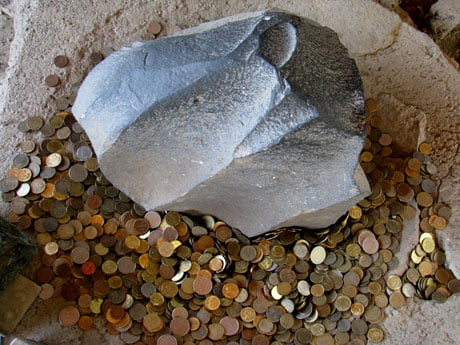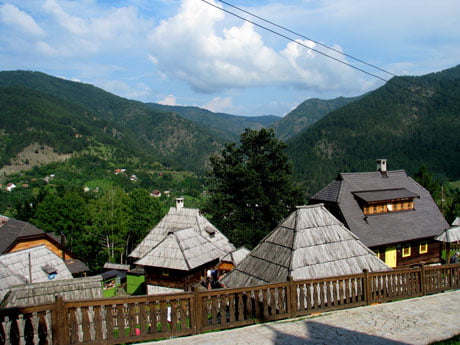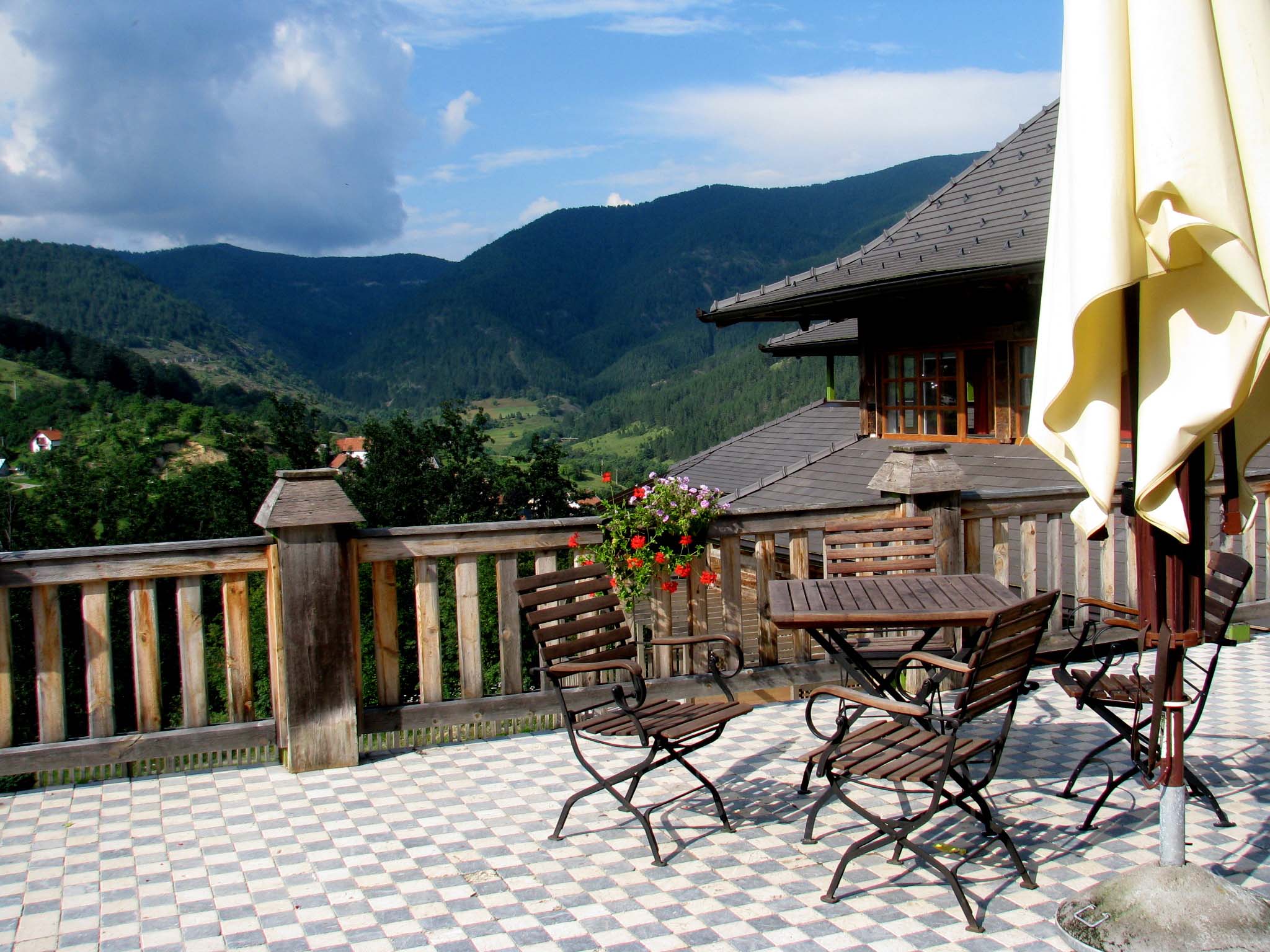
If you need a freelance travel writer or you would like to see your country, city, flight, etc., presented on the blog, drop me an email.
Find our more on Freelance Travel Writer page.
There are a few more places around the town of Užice in Western Serbia that one should visit, among others Kosjerić and Mokra Gora Serbia. And here is why.
If you continue driving towards Tara Mountain, you will reach the stunning Nature Park Šargan-Mokra Gora, famous for Emir Kusturica’s Drvengrad village, the old train route, and the fascinating stories of the clairvoyant Tarabić family. On the other side of town, there’s also a charming settlement called Kosjerić, known for its rural tourism. Such variety awaits!
FROM BELGRADE: to Kosjerić – 135 km, to Mokra Gora – 240 km
FROM NIŠ: to Kosjerić – 240 km, to Mokra Gora – 300 km
Driving from Užice towards Zlatibor and Tara, I took the turn for Tara Mountain and passed through the villages of Tripkova and Šljivovica. There are 20 kilometers of beautiful scenery to enjoy on the way to the village of Kremna. Here’s why you shouldn’t miss it.

Kremna Serbia
The Kremna area stretches across the northern slopes of Zlatibor Mountain. This picturesque village is renowned for the Kremna Prophecy Complex, dedicated to the Tarabić family, who lived here in the 19th century and were believed to possess clairvoyant abilities. According to local lore, they predicted the invention of television, the telephone, and the telegraph in Serbia, as well as political shifts affecting the local throne. The first clairvoyant in the family, Miloš Tarabić, was born in 1809 and reportedly predicted his own lifespan of 45 years.

When I saw the road sign for Kremna, I immediately turned right, but as it turned out, I ended up in the modern part of the village. Returning to the main road, I made sure to stop and admire the wooden statue of Miloš Tarabić. Just three kilometers further along a scenic road, you’ll find the Prophecy Complex.

The entrance leads you through a small wooden gate into a courtyard, where a cozy cottage displays souvenirs and an intriguing exhibition. Here, you’ll discover the so-called Cosmic Stone, unearthed by the military in the 1980s from a depth of 3.5 meters. According to the inscription, the Kremna Valley was formed “when the Earth was created”, with millions of such stones buried beneath. This stone is said to interfere with modern equipment and emit benevolent radiation, which locals believe is the reason for the area’s psychic phenomena.

Visitors are encouraged to leave a coin, make a wish, and touch the Cosmic Stone. Souvenirs include necklaces and keychains containing fragments of the stone. Whatever you think of the tale, the history of the Tarabić family and their prophecies is captivating. The courtyard also features sculptures by self-taught local woodcarver Miladin Lekić, including one intriguingly named “The King in the Barrel.” (Find out more about Lekić in the post about Zlatibor Mountain.)

Legend has it that in the 19th century, Serbian ruler Petar I Karađorđević was hidden inside a rakija barrel to escape capture during a nearby uprising. Remarkably, clairvoyant Mitar Tarabić had earlier pointed to the barrel, saying, “The one who hides here will rule all of Serbia.”
Today, visitors are told to take a picture with the wooden king sculpture to invite personal success. The story takes a whimsical twist with claims that Donald Trump’s photo was once placed inside the barrel before the 2016 U.S. elections!

Nature Park Šargan-Mokra Gora Serbia
This valley in Western Serbia lies between the mountains of Tara and Zlatibor. The Nature Park Šargan-Mokra Gora covers 10,813 hectares and is abundant with gorges, peaks, and valleys containing 700 flora species, many of them endemic. The area was once part of an important Roman road, and remains of Roman cobblestone can be found here, along with several Roman graves. Today, however, Mokra Gora Serbia is best known for the Šargan Eight railway route and the Drvengrad settlement.

Driving back to the main road, I was still thinking about the Tarabić family. Another 12 kilometers and I took the turn towards the first railway station I stumbled across. My train was at 13:30. I found a nice spot to park, thinking I had another 15 minutes or so to stroll around and take a few pictures, even though the station was surprisingly empty. When I finally found someone to ask about the train ticket, they explained that this was the Šargan-Vitasi station and that I should go to the Mokra Gora station, “10 minutes from here.” You can imagine my rush back to the car!
“How would I explain missing the Šargan Eight train, and it goes in a circle!” I smiled.

Šarganska Osmica (Šargan Eight)
This is a narrow railway track of 760 mm that goes over 10 bridges and through 22 tunnels across the Šargan hill, in the shape of an 8 to climb up the steep hill. The number of bridges and tunnels makes it unique in Europe. The composition is pulled by a steam locomotive called Ćira with three stops on the way – Šargan-Vitasi, Jatare, and Mokra Gora. They say that no one has ever bought a ticket in Jatare, and no one has ever come in or out of the train at this station. According to beliefs, Mitar Tarabić predicted that this train would not be used “to go to work, but for fun.” Actually, that’s exactly what happened. The regular route was closed in 1970 only to be reopened in 2003 for tourism purposes.

The train departs at 10:30, 13:30, and 16:10 during the summer season, while the last departure is excluded for the rest of the year. It is advised to call in advance to book a seat. Otherwise, you might only be able to purchase “the standing ticket” or miss the ride altogether. It’s not rare for the train to be full during summer, as groups of Russian and Chinese tourists are frequent here.

The ride lasts for two and a half hours. The train stops a few times, and you will be given a chance to admire the view from several observation decks. One of them is called Golubići, where you will be shown parts of the railway route you covered to get there. Still, it’s not easy to imagine how all those railway tracks you see actually come together at some point, going up and down in seemingly opposite directions!

One should expect to ride in an old wagon with a furnace in the back, to see lovely scenery through the window, to have coffee at Jatare station and enjoy the view of the spring slopes there, to be greeted by the sound of the old steam engine at Šargan-Vitasi station.

And although I now know the route, I still can’t seem to grasp how Drvengrad was once on our left and other times on our right! This is one of the things that makes Mokra Gora Serbia so interesting to see in person.

Drvengrad Serbia
Created by the famous Serbian film director Emir Kusturica, this traditional settlement now houses the Film and Music Festival of Kustendorf. Locals also call it Mećavnik, derived from the Serbian word “mećava” for heavy blizzard. The complex is home to the town’s gate, 13 streets, two squares, cinema, church, restaurants, pastry shop, tennis courts, and swimming pool. Everything is named after renowned people from movies, literature, and sports, such as Ivo Andrić, Stanley Kubrick, Federico Fellini, and Novak Đoković. There are 50 authentic cottages in the complex, gathered here from surrounding villages, which can be rented.
Ever since Kusturica built the settlement in 2003, Drvengrad became a synonym for this part of Serbia. Many people think of Drvengrad when mentioning Mokra Gora Serbia. Additionally, when you remember that this is the place where Johnny Depp or Monica Bellucci came to visit Kusturica or to attend the Kustendorf Festival, it’s even more interesting to stroll along the same cobblestone streets. This is not the first time I have visited Drvengrad, and I was thus impatient to come again and have some traditional ledene kocke cake (Serbian for ice cubes) while gazing at the surreal view of those green mountains. It was late afternoon, dusk was approaching, with not many visitors left except for a group of Russian tourists posing around the settlement.

The entrance ticket for Drvengrad will also serve as a cinema ticket. If you have time, this is certainly a lovely idea. You can stroll around, take photos, have a bite to eat, see a movie, and have some cake before leaving.
In Kusturica’s ethno village, you can, of course, also stay overnight. You can rent either a room or an entire cottage (click on the link), and all accommodations are decorated in a traditional style while offering modern luxuries (TV, floor heating, swimming pool, etc.).
…And now, wait until I tell you about the things to see on the other side of Užice town!

Kosjerić Serbia
This small town lies north of Užice with a population of less than 4,000, according to 2011 data. The river Skrapež flows through, coming from the nearby Povlen Mountain. Kosjerić is surrounded by mountains with the highest hill called Grad (1,022 m). It is believed that this is where the Serbian medieval fortress once stood.
The first settlers came from the Montenegro village of Kosijer, hence the name of the town. It was established by Antonije Kosijer, who came here with his three sons.

It’s good to venture off the main road sometimes. In this case, I took the old road from Užice towards Valjevo town. It takes 30 km to reach Kosjerić, and halfway down the road, I had a good reason to stop for a break. This was the Karan village with the old White Church. For me, it was like a scene from a painting with all those autumn yellow leaves covering the path towards the snow-white church with heavy fog behind it. The church was built in the 14th century. According to its architecture, it belongs to the Serbian Raška style, dating back to the 12th to 14th century. Make sure to stroll around its courtyard because there are also some fascinating Roman tombstones to see!

After this village, the road will take you up and down, through forests, along many curves all the way to Kosjerić. Given that the town is small, you can take a nice long walk. There’s a nice view from one of the bridges, a huge clock on the square, and the Old Han. The building was erected after the Ottoman rule in 1854, and it is now among the protected historical monuments of Serbia. There is also a statue in front of the Han, dedicated to Antonije Kosijer, the founder.

You will come across the monument to Karađorđe, Serbian leader of the First Uprising in 1804, in front of the Cultural Center. There is the National Library dedicated to Sreten Marić, who was born in Kosjerić’s village of Subjel in 1903 and was the famous essayist and Faculty of Philosophy professor in Novi Sad. Marić lived in Serbia and France.
There is also an exhibition here of Liza Marić-Krizanić’s work, along with those depicting her portrait. She studied French in Belgrade and began to paint during her visit to Paris in 1924. Liza started to exhibit in 1939, and her work is kept in Belgrade and Novi Sad museums. One of her first portraits was painted by the renowned artist Pjer Krizanić, who later became her husband.

Kosjeric is also referred to as the Olympic town because of the fountain dedicated to the founder of the movement in Serbia; one of the hotels is called the Olympic, and there is also an Olympic-sized swimming pool. While you stroll along the Skrapež river, you will see the old water mill, sports terrains, and you can also stop by for a tasty trout at the local restaurant. Don’t miss visiting the small village of Seča Reka. It’s not far, and it is believed that the old church-cottage was built here in the 15th century. Now you can see the one erected in 1812 at the same spot. It’s also interesting to admire the few picturesque monuments krajputasi, known to be built by the road dedicated to the 1912 and 1913 Balkan war casualties. (A few years later, I visited this area again with my colleagues. Take a look at the West Serbia Places to Visit post.)

I was lucky to attend the first class of the School of My Ancestors tour in Subjel village, which is now on the Kosjerić Tourism Organization‘s agenda. Snežana, who was head of the local TO, explained that all the children would be dressed in traditional clothes just like their counterparts in 1932 were when this school was reopened for the second time. She compared it to another of their tours – the Serbian Wedding, where tourists take part as brides and grooms and their guests.
And by the way, Subjel was surreal that morning with the hill soaked in the sun and children’s laughter, while the town was still wrapped in heavy fog below.

Still, the thing that Kosjerić is best known for is rural tourism. It has also been a popular destination for children’s excursions for years, with visitors hosted, among others, by Mologošće and Gostoljublje households. At the first one, I was told by Ivana and Mile that they actually lived in the city at first but soon decided to move back here for good. They welcome children’s groups from various schools and kindergartens, from Serbia and abroad. Here, the children can learn old crafts, have a ride on a tractor, make jam and bread, or collect herbs.

As for the other household, I spent the night there and had a chance to talk to Marija and Željko about their experience. Željko is also one of the School of My Ancestors initiators, and besides managing this interesting traditional accommodation complex, he is involved in various projects for cultural heritage conservation.

And I can’t even begin to tell you how delicious Marija’s breakfast was!
Next destination – THINGS TO DO IN PRIJEPOLJE SERBIA
The full THINGS TO DO IN SERBIA section
PIN IT FOR LATER:
If you need a freelance travel writer or you would like to see your country, city, flight, etc., presented on the blog, drop me an email.
Find our more on Freelance Travel Writer page.
I am looking forward to working with you.




10 responses
I have always wanted to visit this part of the world. I am intrigued by the train ride as well as by the history of the area. I really need to get here sooner than later.
You’d be amazed by the variety of places to see and visit. Well, I’m here if you need any info when you decide to go. 🙂
Thank you! <3
Looks like you really dove into learning about the culture here! That is my favorite part of traveling (along with the food). If they believe people are born psychic because of the irradiation from the cosmic stone, did you encounter anyone offering psychic readings?
Hehehe. No, of course not, it’s not that kind of place. 😀
Rather a complex trying to preserve the memory of the family. It’s what the village is known for. And it’s not like they are all clairvoyant here, of course, nobody says that, but the curious thing is that few Tarabic family members were and “this is the reason”, they say. That’s what makes it interesting, when you consider it as part of the tradition of the area. If one is looking for a reading of some sort, this is not the place to be, it’s the memory complex after all. 🙂
I’ve never made it to this place even though i’ve lived in Serbia for a year during my studies. Would love to go and visit all of these places. You wrote such a detailed post that I have to save it for the time when I will go there again.
You lived in Serbia, really? Belgrade or Novi Sad? 🙂
It’s probably time to come again, right? If you do, you’ll find more posts in Weekend in Serbia section. Thank you! 🙂
I love these colorful little towns but most especially when they have history like you outlined in the post. This is what really attracts me to Serbia and this part of Europe in general, it’s full of historical importance but it also still seems to appear now, as it did all those years ago!
So true, that’s what makes them even more interesting to visit. It’s a one of a kind experience!
Thank you. 🙂
Ah, I love Emir Kusturica <3
Great post as always Danijela, thanks 🙂
"School of My Ancestors" sounds interesting. I would love to learn more about it.
Hey Ozlem, thank you! I’m thrilled to hear your opinion, as always. <3
You're so right, that specific tour at the old school is extremely interesting. Was so fortunate to attend the first "class", kids loved it. 🙂